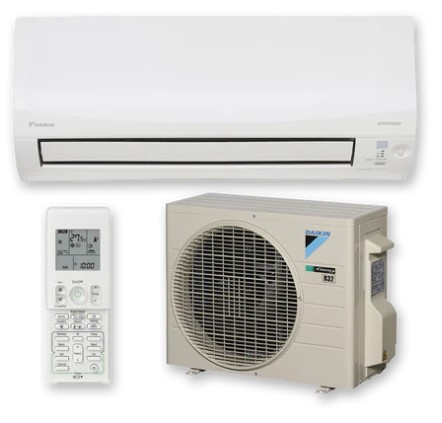Split System Air Conditioner Size Chart
To determine the right size split system air conditioner for a home on the Northern Beaches in Sydney, NSW, you need to consider factors like room size, ceiling height, insulation, window exposure, and the local climate. The Northern Beaches has a temperate coastal climate with warm summers (average highs around 25-28°C) and mild winters, which influences cooling and heating needs. Below is a guide to help you choose the appropriate size, measured in kilowatts (kW) of cooling/heating capacity.
| ✅ General Sizing Guide (based on floor area) | ||
|---|---|---|
| Room Size (m²) | Cooling Capacity (kW) | Typical Room Type |
| 10–20 m² | 2.0–2.5 kW | Small bedroom, study |
| 20–30 m² | 2.5–3.5 kW | Medium bedroom, small living room |
| 30–45 m² | 3.5–5.0 kW | Large bedroom, medium living room |
| 45–60 m² | 5.0–7.0 kW | Large living room, open-plan area |
| 60–80 m² | 7.0–9.0 kW | Large open-plan living area |

Factors That Affect the Split System Air Conditioner Size:
- Insulation – Well-insulated homes need less capacity.
- Windows/Glazing – Large or west-facing windows increase heat load.
- Sunlight – Northern Beaches homes get a lot of sun, especially in summer.
- Room Use – Kitchens need more power due to heat from appliances.
- Ceiling Height – Higher ceilings = more air to cool.
- Number of People – More occupants = more body heat.
Example:
- Small bedroom (12 m²), well insulated → 2.5 kW unit
- Living room (30 m²), moderate windows → 5.0–6.0 kW unit
- Open plan area (50 m²), lots of glazing → 7.0–8.0 kW unit
Tips:
- Don’t oversize: Too large a unit will cool quickly but cycle on/off, wasting power and reducing humidity control.
- Don’t undersize: It will struggle and wear out faster.
- Would you like to give me the exact room dimensions, window sizes, and use case, so I can give you a tailored recommendation?
Step-by-Step Guide to Sizing a Split System Air Conditioner
- Measure the Room Size
Calculate the area of the room (Length x Width in square meters).
Measure ceiling height (standard is ~2.4m; higher ceilings increase cooling needs). - Determine Cooling Capacity Needs
A rough rule of thumb for Sydney’s climate is 0.125–0.15 kW of cooling per square meter for well-insulated rooms with moderate sun exposure. For example:
A 20 m² room may need ~2.5–3.0 kW.
A 40 m² room may need ~5.0–6.0 kW. Adjust based on:
Sun exposure: Add 10–20% more capacity for rooms with large north- or west-facing windows.
Insulation: Poorly insulated rooms may need 20% more capacity.
Ceiling height: For ceilings over 2.4m, add ~10% per extra 0.5m.
Occupancy: Add ~0.5 kW for each additional person regularly in the room (beyond 2 people). - Consider Heating Needs (Reverse-Cycle Systems)
Most split systems in Australia are reverse-cycle, providing both cooling and heating.
Heating capacity is typically similar or slightly higher than cooling. Ensure the unit’s heating capacity suits winter needs (Northern Beaches winters average 8-18°C). - Account for Room Type and Usage
Bedrooms: Smaller units (2.5–3.5 kW) for 10–25 m² rooms.
Living areas: Larger units (5.0–7.1 kW) for 30–50 m² open-plan spaces.
Commercial spaces: May need multi-split systems or larger units (7.1–9.4 kW) for bigger areas. - Local Climate Considerations
The Northern Beaches’ coastal humidity can make rooms feel warmer, so prioritise units with good dehumidification features.
Inverter technology is recommended for energy efficiency and maintaining consistent temperatures.
General Split System Air Conditioner Sizing Guide
Based on web sources and industry standards:
10–25 m² (e.g., small bedroom): 2.5–3.5 kW
25–40 m² (e.g., medium living room): 3.5–6.0 kW
40–60 m² (e.g., large open-plan area): 6.0–9.4 kW
For precise sizing, a heat load calculation is ideal, factoring in windows, insulation, shading, and building materials. Online calculators are not always accurate, as they may overlook these variables.
Recommendations for Northern Beaches
Single room: A 2.5 kW unit (e.g., Daikin Cora series) suits a 15–20 m² bedroom with standard ceilings and good insulation.
Living/dining area: A 5.0–7.1 kW unit (e.g., Mitsubishi Electric MSZ-AP series) for a 30–50 m² space.
Multiple rooms: Consider a multi-split system with one outdoor unit connected to multiple indoor units for zoned cooling/heating.
Brands: Reputable brands like Daikin, Mitsubishi Electric, Fujitsu, and Panasonic are recommended for reliability and efficiency.
Additional Tips
Get a Professional Assessment: Local experts (e.g., Platinum AC, Peninsula Air Conditioning) can perform an on-site quote to assess room specifics and recommend the right unit.
Energy Efficiency: Look for high star-rated inverter units to reduce running costs, especially given rising electricity prices.
Installation: Ensure back-to-back split system air conditioner installation (indoor and outdoor units on the same wall) to minimise costs. Complex setups with long piping increase expenses.
Regulations: Most split systems are exempt from development in NSW, but ensure outdoor units are not on walls facing primary roads and meet noise and placement rules.
Example
For a 30 m² living room with standard 2.4m ceilings, good insulation, and moderate sun exposure:
Base requirement: 30 m² x 0.125 kW/m² = 3.75 kW.
Adjust for large windows (+10%): 3.75 kW x 1.1 = ~4.1 kW.
Recommended unit: A 4.5–5.0 kW reverse-cycle split system.
Next Steps
Measure your room(s) and note window sizes, insulation, and ceiling height.
Contact local Northern Beaches provider Platinum AC at 0423 065 131 for a free on-site quote.
If you provide specific room dimensions or conditions, we can refine the recommendation further!



